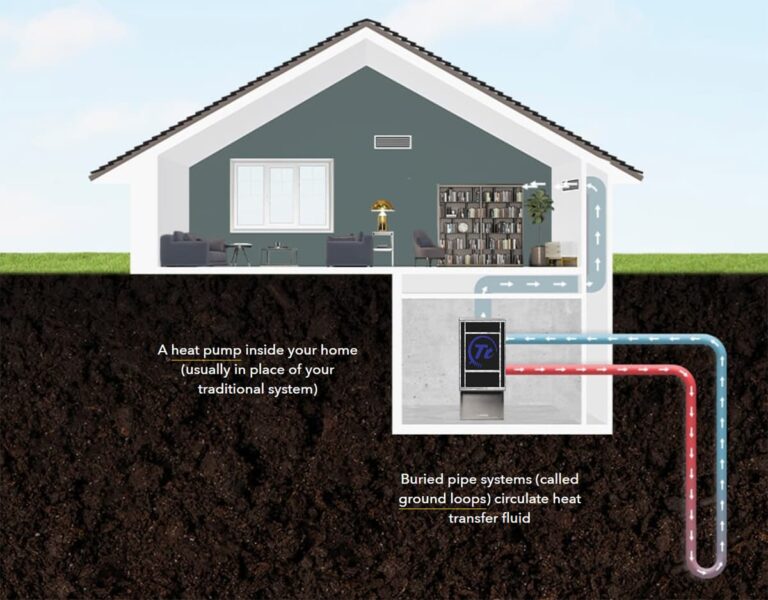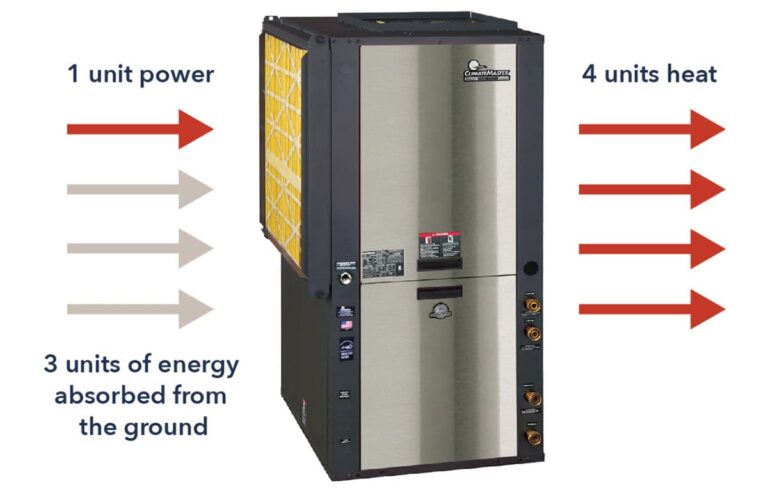At ThermalTran, one of our most important jobs is teaching you how a geothermal heat pump works and, more importantly, why it will improve your life. We’ll start with how the process works, and if you are interested, we have loads of information to satisfy your thirst for knowledge!
How Does Geothermal Heating & Cooling Work?
Whether it’s a winter cold snap or a summer scorcher, the ground five feet below the surface maintains a constant temperature year-round. This constant earth temperature is higher than average winter temperatures and lower than average summer temperatures. If you want an in-depth look into how a geothermal heat pump works, check out the frequently asked questions.

Get Free Quote
What’s the difference between a ThermalTran geothermal installation and a traditional furnace or air-source heat pump?
Energy Independence
- Heat your home efficiently regardless of outdoor temperatures
- Tap into the endless heat below your yard
- Never buy (or run out of) propane or fuel oil again
3-in-1 Heating, Cooling and Hot Water
- One heat pump to rule them all!
- Unparalleled efficiency from a system that will heat and cool your home
- Many of our systems can provide all your water heating needs as a byproduct of its operation!
Convenient
- More time with less hassle
- Say goodbye to frequent maintenance visits, service calls, and fuel deliveries
Increase Your Home’s Value
- Invest in your home and reap the rewards
- Fuel, propane, and air-source heat pump customers can save $1,000s on heating and cooling every year!
Long-Lasting Equipment
- Count on reliable heating and cooling for decades to come
- Geothermal heat pumps typically last 20 to 25 years
- Ground loops install in the yard can last more than 100 years!
Hyper-Efficient
- Unorthodox efficiency for a more comfortable home or business
- Up to 8.7 times the heat output compared to work input (COP)
- The higher the efficiency, the more money saved
Safer
- No flames and no fumes
- Furnaces have the potential to produce serious health hazards like carbon monoxide, sulfur dioxide, and nitrogen dioxide
- No moving parts outside your home
Tax Incentive
- Another reason why now is a great time to upgrade to geothermal
- Qualify for generous federal, state, and utility tax incentives to lower your installation costs
Getting a Thermaltran Geothermal Heat Pump Installation is Simple.
Step 1
Contact our office to schedule an in-person consultation.
Step 2
A trained ThermalTran energy consultant will visit your home or business to answer your questions and conduct a site survey. A trained geothermal system designer will walk you through the site survey process. This visit helps us determine your geothermal system’s best location, size, and design.
Step 3
ThermalTran provides several options to consider for your geothermal installation. We consider your budget and the features you want to be included in your system. We’ll explain all the options so you don’t have to decode a mystery. Hint: Free hot water is an option!
Step 4
ThermalTran engineers and technicians install your new geothermal system. We’ll install your geothermal system in 3 stages: drilling and installing the underground loop, connecting the ground loop to your home, and installing the heat pump where your old air-source air handler or furnace used to sit. Each step can take two days or up to two weeks to complete depending on your local geography and project complexity.
Step 5
Relax and enjoy your comfortable home for years to come.
Congratulations! You are now the proud owner of the most efficient heating and cooling equipment available. Geothermal for the win!
What’s included with your ThermalTran geothermal system?
- Hand-picked ClimateMaster, Waterfurnace, or Bosch geothermal heat pump
- 10+ year product warranty
- 3-year ThermalTran Geothermal Workmanship Guarantee
- Indoor and outdoor installation, including drilling, labor, and materials.
- Removal of the old heat pump or furnace, air handlers, or other equipment
- Smart Thermostat

Geothermal Heat Pump FAQs
All You Need to Know About Home Geothermal Heating & Cooling
What exactly is home geothermal heating and cooling?
It’s an HVAC system that can save homeowners serious money on utility bills. Unfortunately, many people have never heard of home geothermal, or they don’t understand it. Many people think it has something to do with capturing heat from volcanoes or geysers. (It’d be cooler if it did!)
However, that would be pretty tricky to pull off for most homeowners, and it would seriously limit the number of people who could take advantage of geothermal energy.
Thankfully, you don’t have to live anywhere near an active volcano to have an effective, money-saving home geothermal system installed.
Home geothermal heating and cooling is actually reasonably simple. Here’s a great video from the team at Bosch that teaches the basics:
https://www.youtube.com/watch?v=q9DP6v0IW1k
How does home geothermal energy work?
The earth’s temperature in the Coastal Carolina area 6 feet below surface level is a constant 58-64 degrees Fahrenheit year-round. For simplicity’s sake, we’ll assume the average ground temperature in the area is 63°F since that temperature is most common in our area. Thus, when the air outside your home is below freezing, just 6 feet below the snow-covered ground, it’s still 63 degrees. Or when summer brings 96-degree weather, the earth beneath your house remains steady at 63 degrees.
You have probably experienced this phenomenon in homes with basements without even realizing it. When you go into a basement on a hot day, it’s nice and cool because the earth on the other side of the foundation is, you guessed it, 63 degrees.
In the winter, even an unheated basement in North Carolina stays relatively warm because of that consistent 63-degree insulation from the surrounding earth.
Geothermal systems, such as those ThermalTran installs, take advantage of this naturally occurring constant. They harness the steady temperature surrounding any home to heat or cool it as needed.
Although it’s referred to as geothermal energy, geothermal and other home geothermal systems don’t make electricity. They use the sustained temperature of the ground to heat or cool your home.
What are the differences between geothermal systems?
Though many geothermal systems are similar, there are differences between them. Some used a closed or open loop system, pond loops, or slinky coil ground loops.
There are pros and cons to the various loop configurations for geothermal home heating. ThermalTran designers and engineers use closed-loop systems most frequently. They see them as the most efficient and safest option for homeowners.
When a ThermalTran geothermal system is installed, closed-loop pipes filled with pure water are buried in the ground beneath your home. “Closed loop” means the pipes are connected to only your house. They aren’t connected to a larger infrastructure and won’t interact with any fluid outside your system.
As water circulates through your heat pump’s pipes, the water within the pipes changes temperature. In the wintertime, this 63-degree water is warmer than the outside air. ThermalTran designs a system that pulls this warm water through the pipes and uses a heat pump to warm the air in your home. This flexibility allows you to adjust the air in your home to whatever temperature you desire.
The same principle works in reverse in the summertime when your geothermal system uses the temperature of the ground to cool the air in your house. It doesn’t matter if it’s a crisp 35 degrees or a toasty and humid 88 degrees outside. Your geothermal system makes it easy to get comfortable at home.
Is geothermal really worth it?
Installation of a ThermalTran system can save homeowners up to 50% on their heating and cooling bills every month. It’s a wise investment that leads to long-term savings, all while keeping your home comfortable all year round.
In the U.S., heating and cooling residential and commercial buildings contribute about 11 percent of the nation’s total carbon dioxide emissions.
Home geothermal systems create zero carbon emissions. Over the course of a year, using one geothermal system reduces enough carbon emissions to equal removing two cars from the road.
These engineering wonders are also safer for your home than traditional heating and cooling systems. With ThermalTran geothermal, there’s no risk of explosion or carbon monoxide leaks to endanger your family.
Geothermal heating and cooling cost
While the price of electricity, oil, or natural gas fluctuates, the cost of operating a geothermal system will remain relatively the same. The electricity costs of a geothermal system are low and seldom vary from month to month.
Despite their many advantages, installing a conventional geothermal system for a typical home used to cost up to $50,000 or more.
However, engineers and installers set out to drive those costs down. Thanks to their ingenuity, geothermal systems are now affordable to more homeowners.
A complete ThermalTran Mechanical home geothermal system typically costs $18,000 to $29,000 when adding a ground loop for the first time on an average-sized house. ThermalTran has no-money-down financing plans allowing homeowners to install a geothermal system with no upfront cost. Click to learn more about pricing.
